084 of
150: BCATP: Cover For Convoy
This short story was published in the Legion Magazine,
February 1973.
Cover for Convoy
Reprinted with permission from the London Free Press
By Helen Waugh
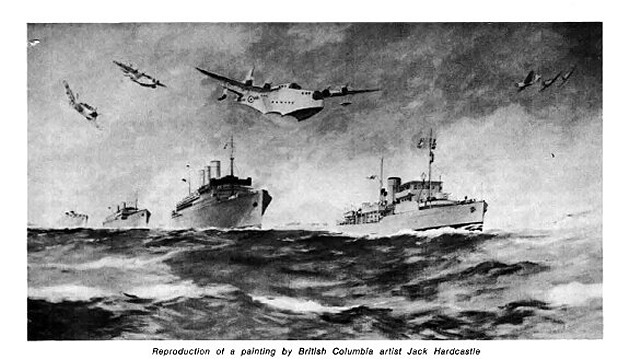 It was a large uninteresting brown paper envelope, headed
at the top with the letters OHMS and RCAF underneath. At the bottom was
the warning: Don't waste words - Don't waste paper." Inside the envelope
was a book. It was labelled Royal Canadian Air Force, Pilot's Flying Logbook.
The pilot's name must have been written by himself at the bottom, but was
indecipherable now from frequent handling.
It was a large uninteresting brown paper envelope, headed
at the top with the letters OHMS and RCAF underneath. At the bottom was
the warning: Don't waste words - Don't waste paper." Inside the envelope
was a book. It was labelled Royal Canadian Air Force, Pilot's Flying Logbook.
The pilot's name must have been written by himself at the bottom, but was
indecipherable now from frequent handling.
A few typewritten words under the Royal Canadian Air Force
letterhead informed her that: "The enclosed Logbook, which is part of the
service estate of the above named, is passed herewith for your retention."
It was signed by a wing commander for chief of the air staff.
The first page enumerated the pilot's certificates of
qualification such as, first pilot of Tiger Moths, Harvards, Spitfires
and Lysanders. Then followed a record of his life, day by day, from AC2
to FO. There were the dates, names of his instructors with the results
of tests and remarks. All very methodical.
She felt his excitement when he first wrote "Self" under
the pilot's name. She had the same feeling when she read "first solo."
She remembered the letter that told about his first flight alone. He wrote,
"Up above the clouds is another world and one is another person. I would
not have been surprised to see the fairy castles of Mother Goose loom up
in front of me."
There were special entries such as "cross country" and
"50.hour check," followed by "dual navigation," "map reading" and "night-flying".
Then came the certificate which made him a pilot having passed written
and cockpit tests to the satisfaction of Wing Commander So and So. This
meant graduation. Relatives did not go to graduation in 1941. A pity. She
wished she had that memory. He was so proud of his wings.
Two blank pages followed. Not blank to her though, but
alive with a vivid picture of his embarkation leave days; the sound of
laughter and young voices, the memory of his warm smile as he ran down
the steps. She had waved him off as she had waved his father off to another
war.
England and the entries told of Miles Masters and Spitfire
planes, alternating down the column, sometimes with an instructor, generally
alone, mention of dogfighting aerobatics and sometimes a landing at this
place or that, reason not explained. Aerobatics – she smiled. He had written
: "We looped the loop, banked this way and that, all very exciting, but
when we landed I slipped behind the drome and lost my breakfast! "The best
of them did that."
Page after page told his daily story, with the flying
hours mounting up. Circuits and landings, formations, formations, formations,
cloud flying and air-firing at D with notation: "Not so Hot." Assessment
of ability as pilot: "Above the average." She glowed. There were the little
notes such as "Crashlanded at W., lack of petrol," "Hit telephone pole"
and one which landed him in hospital.
He wrote about that one: "Landed In some trees, came to
a stop two fields away, with only the engine and cockpit Intact, but passenger
and myself not scratched - not much. Guess I was born to be strung up,
Mom!"
Then there was the strident note in red ink which said
briefly: "Endorsed for disobedience after flght." Oh-oh, always the nuisance
boy. He wrote about that too, rather naively, "Had words with my flight
commander, he got mad and I laughed, so I am leaving this squadron."
The change seemed to have pleased him. He was now on Lysanders.
It was about this time that two Jerry warships made headlines by a dash
through the Channel. She had shivered at the news on the radio that told
her "forty of our planes are unaccounted for." For two days the sound of
the doorbell terrified her. Later he had written : "The Jerries were all
about me in the fog, and I was badly scared as my plane carries little
armament."
He was back to the Spitfires, working hard for the great
day he mentioned so often now in his letters. He wrote : "The improved
Spitfire is a beautiful job, but a flying arsenal, and I have a lot more
to learn about it."
He leaned through page after page of machine gun calibrations,
formation flying, formation interception. Moves from one Squadron to another,
refresher courses, one after another. It was at this time that he joined
the squadron where he spent his last year, a year of the great excitement
of "ops". Moments of triumph and fear.
The records of operations were brief, as if he feared
to say too much. There was "a sweep to T, no trouble at all" or "patrol
channel, nothing seen,"Thunderbirds had all the fun again.’’ Now and then
a bit of action like, "took a squirt at a 109F, damaged it." "Burst a tire
on takeoff - landed OK, surprised myself," or "Got a train in France."
There was a short note, "Lost Bob," and she wondered,
was Bob's mother reading his logbook too? The flying hours went up and
up and escort duty took him to many places.
At last the invasion, though the record seemed as laconic
as before.
"Invasion started - fighter cover for beachhead" she read.
"Hit by flak just behind the cockpit."
He had changed planes the next day when he noted "Fighters
around -- flak heavy." Then the last short entries with no added notes
"Cover for invasion -- escort for Bostons -- cover for convoy." That was
the last entry and the end of the month.
The first two days of the next month which had not been
logged, his squadron had been cover for convoy too. She knew about
the third day. It was on that page that she recognized the two signatures
of the flight commander and the squadron leader for they had both written
to her.
They had said : "A great little fighter pilot – his services
to the squadron in all its activities were invaluable."
She closed the book, took it to the living room and put
it on the bookcase below his picture. She looked at the picture, firm,
stern and old for his 26 years. She replaced the book in its brown paper
envelope and saw again "Don't waste words -- Don't waste paper". Only lives,
dear God, young gay lives, their ambitions and sweet dreams unfulfilled.
Through her jangled thoughts came the clear ringing of
a bell. Prayers for peace at the mission church across the road. Blindly
she turned to the hall. Her steps echoed on the porch and crunched the
gravel of the drive.
A few children were trying to force open the chapel door,
swollen by the recent rains. She opened it for them and under her outstretched
arm they tramped noisily in, smiling up at her as they passed. She smiled
too.
"Cover for convoy," she thought, and followed them in!
085 of
150: A WWII Memory - Sam and Glen Merrifield - Part 6
At Pocklington I had my first airplane
ride. This day Tom and I were repairing a TR9 (radio) when a crew of two
pilots came to get the aircraft, accompanied by a flight commander who
was to check them out on circuits and bumps. They said they did not need
the command set and that we could continue working. The first time around
I was thrilled and did more watching than working. Now this was a dual
control machine which meant a flip up seat for the second dickey blocked
the main aircraft entrance. The second time around, the new boys took over,
and with the guidance from the instructor we made it in. Tom and I were
busy working as we heard the door go slam as a voice said, "That's it,
you can kill yourself without me aboard... have fun." Well the engines
roared and we took off again. The first try we overshot and went around
again, the second try we bounced her in from much too high and we informed
the novices that if they did not let us out there would be no more circuits
unless they wanted to fly with us pounding on them from behind. We enjoyed
the ground when we got back onto it. I received a few anecdotes from Russ
"Stoney" Stonehouse, an AEM (Aircraft Engine Mechanic), now a resident
of Digby, N.S., in January 1981 and recount them here as they tell their
own story.
Remember how we did battle getting to the NAAFI wagon
for tea, buns and drippings?
Remember how on clothing parade the old stores keeper
would not issue replacement gloves for our RCAF issue... reason... leather
gloves were not an RAF issue. How we would size up a new ruddy Canadian
posted to the squadron and try and con his oldest RCAF uniform for our
best blues. Remember Pocklington, Yorkshire in 1941 doing aircraft duty
on old Wimpies with rifle and all and doing guard duty at entry points
to the airdrome and the Colonel in the RAF Regiment who loved to personally
catch you sleeping at the post, wake you up, demand a salute, then put
you on a charge?
Remember also in 1941 at Pocklington having to be alerted
to DRO's to see if your name was posted for the famous Backers Up Course,
as they called it, headed up by the RAF Regiment. This was set up to give
us proper training to fight the Hun when they parachuted into England.
On this exercise you reported to the Station armament Section to draw your
firearm. I like many of the fellows ran around the Yorkshire Moors for
about two weeks with a piece of metal with a bayonet welded on the end.
I thought how safe it was with such equipment including wooden anti-aircraft
guns with sand bag encasement. The bottom line of the course was the enactment
of the Germans landing or arriving at the squadron. What a fiasco. Because
we were not going to be issued with at least a weekend pass for doing the
course the Canadians started throwing rocks at Station Headquarters and
only two casualties resulted from broken glass. Gad how lucky we were Hitler
decided to attack Russia.
Getting to the more serious aspect of the war and our
effort as a squadron. Remember Christmas 1941 at Pocklington and the squadron
being on standby for an operation. The running up of the old Wimpies every
hour on the hour so as to be ready. The target was to be Brest (as we later
learned) to try and get a famous German Battleship docked there. Not too
many weeks later and after bombing raids on Brest and devastating the pocket
battleship it sailed up the channel without incident for the fjords of
Norway. The Germans had her so well camouflaged and protected in Brest
that the raids caused no harm. The time the German Night Fighter was shot
down near Pock, The pilot went for it and what a grand funeral he was given.
A parade with the casket draped with the Swastika and carried on a flatbed
vehicle. Unfortunately the pilot had to go minus his Iron Cross and beautiful
high leather boots. They went missing almost immediately when he was taken
to the Station morgue. Coming home in 1945 on the troopship Mauretania
I was shown the Iron Cross, the boots were gone when this party arrived
to pay respects... end of Stoneys Pock remembrances.
Our cousin Lloyd Brown, at that time a Sgt WAG (Sergeant
Wireless Air Gunner), visited us during the early spring of 1942 while
finishing his training at an OTU (Operational Training Unit in the Midlands.
Lloyd and I met twice more before he was killed during this training on
May 6, 1942. "Ginger" as we called him, and I met by chance at the Beaver
Club while I was on leave in London and at Covent Gardens Opera House,
converted to a wartime dance hall, on another occasion. Lloyd is buried
at Kempston Cemetery near Bedford and I hope to visit his grave during
our Memorial Window Reunion in the spring of 1989.
The winter of 1942 gave us some heavy snow and bitter
cold weather. Being Canadians we were expected to be able to handle the
snow and we did - everyone - and I mean everyone ~ shovelled snow and we
were able to keep our drome open and operational. The only one in 4 Group
and that meant we had other aircraft as well as our own to look after.
There are two side stories to the wintery conditions.
The first was the cold weather made it necessary to sand the runways to
help the alc brake to a stop on the slippery runway. After the spring thaw
this sand started cutting the a/c tires and we had to go out and sweep
it. You can believe me a runway takes a lot of shovelling and sweeping.
The second story results from Pock being a temporary wartime
drome with the water and sewer lines too close to the surface to withstand
this unseasonable weather. Our toilets soon became solid blocks of ice
and so polluted that we took turns going into York for a decent wash in
one of the Cinema washrooms. This cold weather only lasted a few days and
then all back to normal.
I do not remember the squadron pictures being taken when
we had the Winipies but they were. I obtained copies from Mac McCrady here
in Vancouver in the mid 1980s. Copies were never made available to the
rank and file as they were in the Leeming picture so maybe that has something
to do with it.
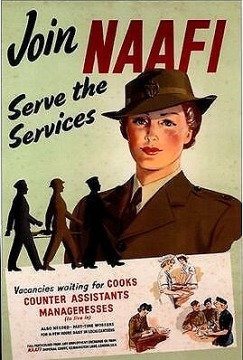 .
.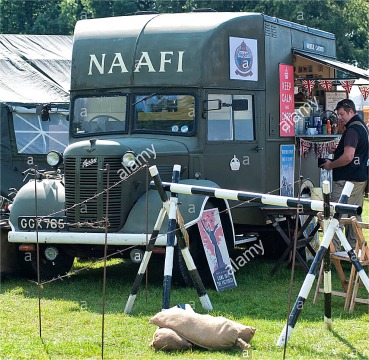 .
.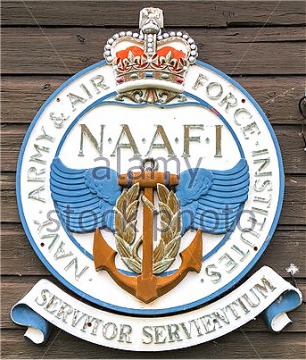
No. 1 Flight Engineers School - Aylmer Ontario
Created in 1921 by the British government, the Navy Army
Air Force Institute was tasked to run recreational establishments for the
the British Armed Forces and provide servicemen and their families with
necessities for sale. Still in action today, NAAFI is run by civilians
and offers supermarkets, launderettes, restaurants, clubs, bars, shops
and the iconic NAAFI wagons. They are located on most British bases and
as canteens on many British Navy ships. Officers are expected to find their
necessities in the Officer’s Meeses. Duting World War II, by April 1944,
7000 NAAFI canteens were in operation with 96000 personnel. It also controlled
ENSA, the armed forces entertainment organization.
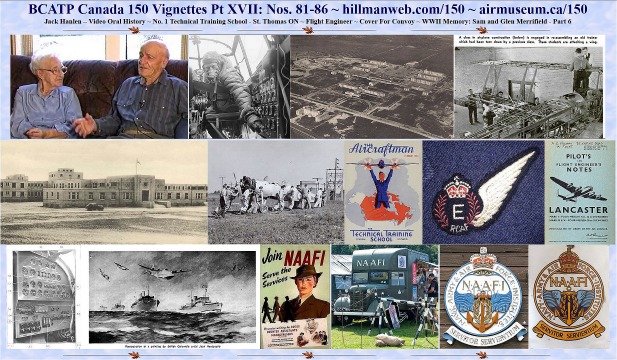
Click for full-size promo collage poster
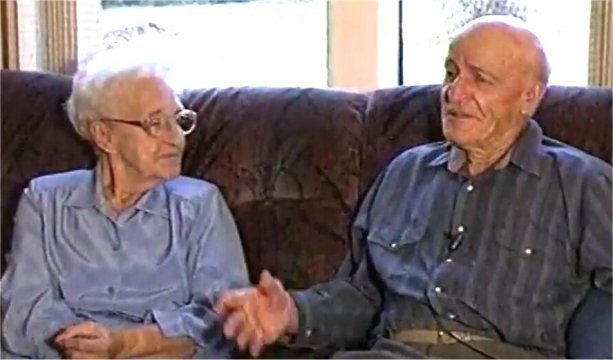 .
.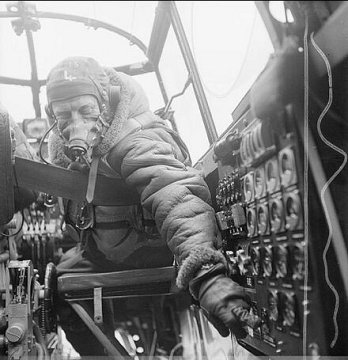
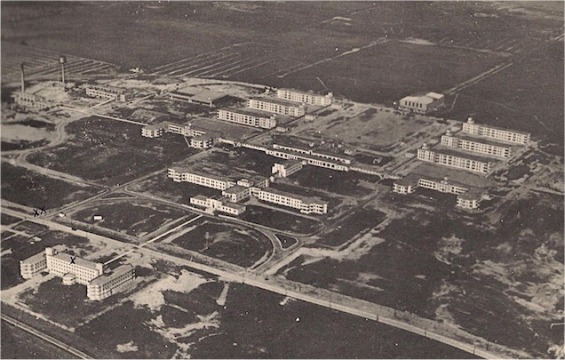
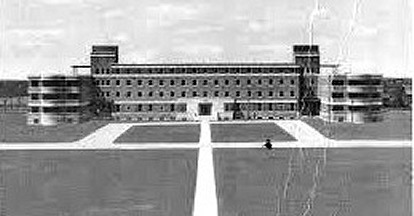
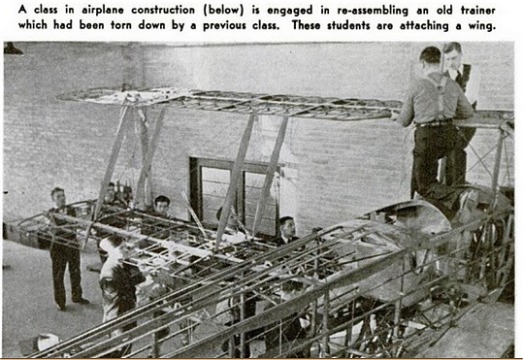
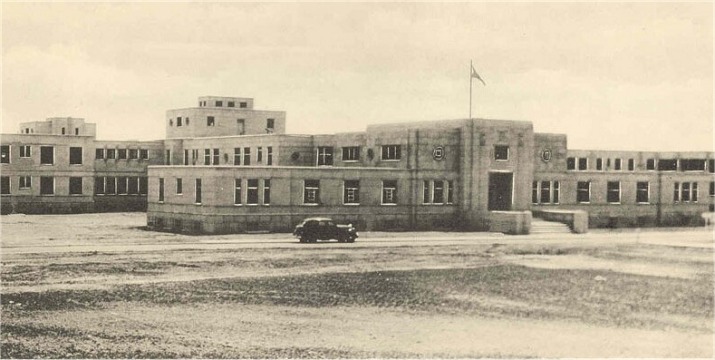
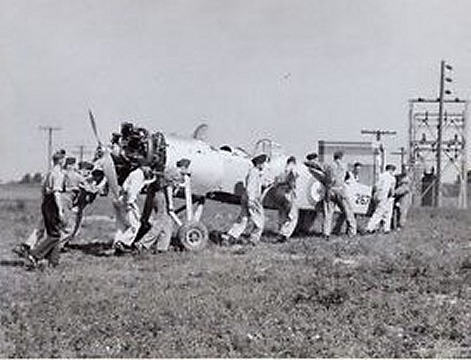
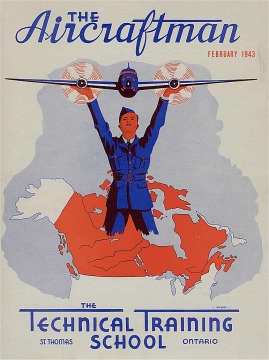
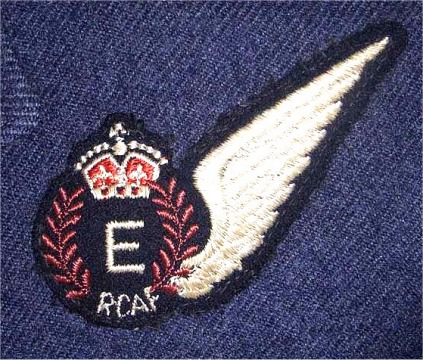 The
Avro Lancaster and Handley Page Halifax bomber aircraft in service to Bomber
Command during World War II utilized a crew of seven airmen including a
mid-upper gunner, rear gunner, wireless operator, bomb aimer/gunner, navigator,
pilot and flight engineer. Other British aircraft including the Short Stirling
included a flight engineer. Missing from this crew was the co-pilot whose
duties were assumed by the flight engineer and pilot.
The
Avro Lancaster and Handley Page Halifax bomber aircraft in service to Bomber
Command during World War II utilized a crew of seven airmen including a
mid-upper gunner, rear gunner, wireless operator, bomb aimer/gunner, navigator,
pilot and flight engineer. Other British aircraft including the Short Stirling
included a flight engineer. Missing from this crew was the co-pilot whose
duties were assumed by the flight engineer and pilot.
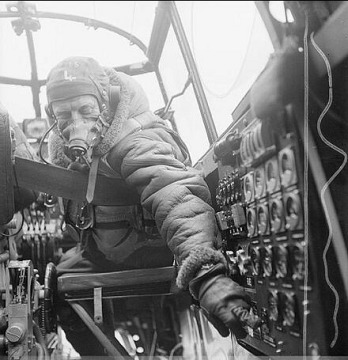
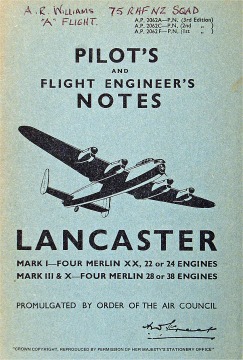
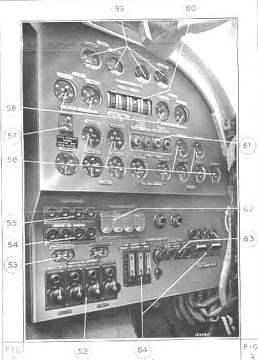

 .
.

